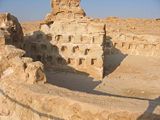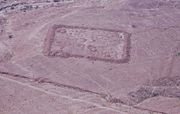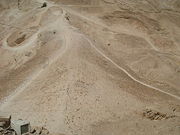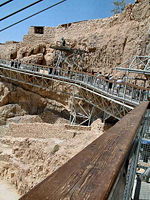Masada
| Siege of Masada | |||||||
|---|---|---|---|---|---|---|---|
| Part of First Jewish-Roman War | |||||||
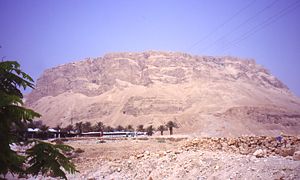 Masada seen from the east | |||||||
| |||||||
| Combatants | |||||||
| Jewish Zealots | Roman Empire | ||||||
| Commanders | |||||||
| Elazar ben Ya'ir | Lucius Flavius Silva | ||||||
| Strength | |||||||
| 960 | 15,000 | ||||||
| Casualties | |||||||
| 953 | Unknown, if any | ||||||
Masada (a romanization of the Hebrew מצדה, Mitzada, from מצודה, metzuda, "fortress") is the name for a site of ancient palaces and fortifications in the South District of Israel on top of an isolated rock plateau on the eastern edge of the Judean Desert overlooking the Dead Sea. Masada became famous for its significance in the First Jewish-Roman War (Great Jewish Revolt), when a siege of the fortress by troops of the Roman Empire allegedly led to a mass suicide of the site's Jewish defenders when defeat became imminent. While the fate of the rebels is disputed, Masada came to symbolyse for Jews courage, patriotism and self-defense. Its story helped to inspire the Warsaw Uprising during World War II. Modern Israeli soldiers vow to defend the State of Israel standing atop the fortress.
Geography
The cliffs on the east edge of Masada are about 1300 feet high, dropping off to the Dead Sea, and the cliffs on the west are about 300 feet high; the natural approaches to the cliff top are very difficult. The top of the plateau is flat and rhomboid-shaped, about 1800 by 900 feet. The center of the plateau is at {{#invoke:Coordinates|coord}}{{#coordinates:31|18|55|N|35|21|13|E| | |name= }}. There was a casemate wall around the top of the plateau totaling 4300 feet long and 12 foot thick with many towers, and the fortress included storehouses, barracks, an armory, the palace, and cisterns that were refilled by rainwater. Three narrow, winding paths led from below to fortified gates.
History
According to Flavius Josephus, a first-century Jewish Roman historian, Herod the Great fortified Masada between 37 and 31 B.C.E. as a refuge for himself in the event of a revolt. In 66 C.E., at the beginning of the First Jewish-Roman War (also called the Great Jewish Revolt) against the Roman Empire, a group of Jewish rebels called the Zealots (kana'im, "zealous ones," commanded by Elazar ben Ya'ir (who may have been the same person as Eleazar ben Simon), who objected to Roman rule of Judea (as the Roman province of Iudaea, its Latin name) took Masada from the Roman garrison stationed there. In 70, they were joined by additional Zealots and their families who were expelled from Jerusalem by the other Jews living there shortly before the destruction of Jerusalem (and the Second Temple), and for the next two years used Masada as their base for raiding and harassing Roman and Jewish settlements alike.
In 72, the Roman governor of Iudaea, Lucius Flavius Silva, marched against Masada with the Roman legion X Fretensis and laid siege to the fortress. After failed attempts to breach the wall, they built a circumvallation wall and then a rampart against the western face of the plateau, using thousands of tons of stones and beaten earth. Josephus does not record any major attempts by the Zealots to counterattack the besiegers during this process, a significant difference from his accounts of other sieges against Jewish fortresses, suggesting that perhaps the Zealots lacked the equipment or skills to fight the Roman legion. Some historians also believe that Romans may have used Jewish slaves to build the rampart, whom the Zealots were reluctant to kill because of their beliefs.
The rampart was complete in the spring of 73, after approximately two to three months of siege, allowing the Romans to finally breach the wall of the fortress with a battering ram on April 16. When they entered the fortress, however, the Romans discovered that its approximately 1000 defenders had set all the buildings but the food storerooms ablaze and committed mass suicide rather than face certain capture or defeat by their enemies (which would probably have led to slavery or execution). Because Judaism strongly discourages suicide, however, the defenders were reported to have drawn lots and slain each other in turn, down to the last man, who would be the only one to actually take his own life. The storerooms were apparently left standing to show that the defenders retained the ability to live and chose the time of their death over slavery. This account of the siege of Masada was related to Josephus by two women who survived the suicide by hiding inside a cistern along with five children and repeated Elazar ben Yair's final exortation to his followers, prior to the mass suicide, verbatim to the Romans.
Masada today
The site of Masada was identified in 1842 and extensively excavated in from 1963 to 1965 by an expedition led by Israeli archeologist Yigael Yadin. A pair of cable cars now carries those visitors who do not wish to climb the ancient Snake Path, now restored on the eastern side of the mountain (access via the Dead Sea road). The area remained largely untouched by humans or nature in the past two millennia, due to the location's remoteness from human habitation and its arid environment. The Roman ramp still stands on the western side and can be climbed on foot. Many of the ancient buildings were restored from their remnants, as were the wall-paintings of Herod's two main palaces, and the Roman-style bathhouses that he built. The synagogue, storehouses, and houses of the Jewish rebels were also found and restored. The meter-high circumvallation wall that the Romans built around Masada can be seen, together with eleven barracks for the Roman soldiers just outside this wall. Water cisterns two-thirds of the way up the cliff drain the nearby wadis by an elaborate water system, which explains how the rebels managed to have enough water for such a long time.
The Masada legacy has been used in a similar context by the British Mandate of Palestine, which planned the Masada plan to man defensive positions on Mount Carmel with Palmach fighters, in order to stop Erwin Rommel's expected drive through Palestine in 1942. The plan was abandoned following Rommel's defeat at El Alamein. When Moshe Dayan was the Israel Defense Forces' Chief of Staff, troops finishing their Tironut started to regularly participate in swearing-in ceremonies in Masada, where participants swear the oath that "Masada shall never fall again." Hundreds of soldiers climb at night in rows through the Snake Road and then swear in with torches lighting the background. This was customary for troops of the Israeli Armor Corps, the Givati Brigade and others.[1] Marches to Masada are still popular in the IDF and a requirement for many units such as nahal.
Masada has been a UNESCO World Heritage Site since 2001. An audio-visual light show is presented nightly on the western side of the mountain (access by car from the Arad road or by foot, down the mountain via the Roman ramp path).
ReferencesISBN links support NWE through referral fees
- Avi-Yonah, M. et al., Israel Exploration Journal 7, 1957, 1–160 (excavation report Masada)
- Ben-Yehuda, Nachman. Sacrificing Truth: Archaeology and the Myth of Masada. Amherst, N.Y.: Humanity Books, 2002ISBN 9781573929530
- Tamarin, Alfred H., and Flavius Josephus. Revolt in Judea, the Road to Masada: The Eyewitness Account by Flavius Josephus of the Roman Campaign against Judea, the Destruction of the Second Temple, and the Heroism of Masada. New York: Galahad Books, 1975 ISBN 9780883652831
- Yadin, Yigael Masada: Herod's Fortress and the Zealots Last Stand , NY: Welcome Rain, 1998 ISBN 9781566490337
- Yadin, Yigael Israel Exploration Journal 15, 1965 (excavation report Masada)
- Yadin, Yigael. Bar-Kokhba; the Rediscovery of the Legendary Hero of the Last Jewish Revolt against Imperial Rome. London: Weidenfeld and Nicolson, 1971 ISBN 9780297003458
External links
- Masada by Google Maps Retrieved August 28, 2007.
- Masada in the Jewish Encyclopedia Retrieved August 28, 2007.
- The credibility of Josephus Retrieved August 28, 2007.
- LIVIUS article on Jewish Wars Retrieved August 28, 2007.
- World Heritage Sites page Retrieved August 28, 2007.
- Israel National Parks Authority page Retrieved August 28, 2007.
Credits
New World Encyclopedia writers and editors rewrote and completed the Wikipedia article in accordance with New World Encyclopedia standards. This article abides by terms of the Creative Commons CC-by-sa 3.0 License (CC-by-sa), which may be used and disseminated with proper attribution. Credit is due under the terms of this license that can reference both the New World Encyclopedia contributors and the selfless volunteer contributors of the Wikimedia Foundation. To cite this article click here for a list of acceptable citing formats.The history of earlier contributions by wikipedians is accessible to researchers here:
The history of this article since it was imported to New World Encyclopedia:
Note: Some restrictions may apply to use of individual images which are separately licensed.
- ↑ Dan Bitan, Mesada the Symbol and the Legend, the Dead Sea and the Judean Desert, 1960, Yad Ben Zvi
